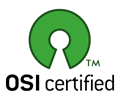[insert project logo here (125x200px max)]
Navigator
Mailing-lists
Please report any errors or omissions you find to our `Help' mailing-list, or post a message in the Forums.
Copyright and Licensing Information
Snap is (c) Jonathan T. Moore, 1999-2002 and licensed under the GNU General Public License (GPL).
All other parts of Splash are (c) Willem de Bruijn, 2002-2003 and licensed under the BSD Open Source License.
All sourcecode is made publicly available.
Acknowledgment
Splash and the Splash website are hosted by SourceForge.net
Splash
SNMP Plus a Lightweight API for SNAP Handling
Introduction
SPLASH can serve as a drop-in replacement for a standard snmpd daemon. The application is based on an active network environment named SNAP. It supports all existing SNMP-based management applications at no extra cost in performance. At the same time, SPLASH provides much richer functionality by permitting SNAP-based management agents to roam around the managed objects, gather information, or even fix problems without necessarily `reporting back to base'.
With SPLASH, network managers are able either to issue simple SNMP requests to the network elements, or to distribute part of the management load to the nodes themselves via SNAP. Both models are useful and which one is the most suitable will depend entirely on the application. As a side note, SPLASH's seamless support for SNMP may well make it a good vehicle for more widespread deployment of Active Networking technology.
Glossary of Terms
Network Management
The term Network Management (NM) refers to the task of maintaining computer networks in working order. It consists of both monitoring and configuring tasks and encompasses many areas, of which the most commonly mentioned are:
- Fault Management
- Configuration Management
- Accounting
- Performance Management
- Security Management
Introductions into Network Management:
- NM entry in `Connected: An internet Database'
- Network Management; What it is and what it isn't, by Douglas W. Stevenson
SNMP
In the early days of networking remote shell access to most systems was made possible using tools such as Telnet and Rlogin. During the 1980's many suppliers of networking components began adding proprietary management tools to their systems, such as Netview by IBM, Accumaster by AT&T and DMA by Digital Equipment.
Recognizing the need for a standardized communication framework, the Internet Architecture Board initiated a process of discussion in 1988 that led to the Simple Network Management Protocol. SNMP has been around since 1989, when the first version was defined as a soon to be replaced protocol. As is often the case, the system became so widespread that it is still in use today and will probably be so for quite a while.
SNMP is a framework for network management standardized in Request For Comments (RFC) documents. It consists of definitions for:
- an overall architecture
- the structure and identification of management information
- communication protocols
- operations for accessing management information
- a set of fundamental applications
The predominant SNMP package under UNIX systems, especially open source platforms as FreeBSD and Linux, is the net-snmp package originally developed at the University of California at Davis. Previous versions of this package were named ucd-snmp for obvious reasons and are still in use today. Besides being widely supported and actively developed the net-snmp package's source code is distributed under a BSD like open source license.
More information on SNMP can be found at:
- the SNMP FAQ (from comp.protocols.snmp)
- intro from RAD Data Communications. Ltd.
- intro from Cisco Systems
Active Networking
Active Networking (AN), closely related to Mobile Agent Platforms and Programmable Networks, allows data packets travelling through a network to contain executable code. The software running on the nodes only executes programs embedded in the data packet and displays its information to the packets. AN systems can increase network flexibility by changing policies based on the nature of the data.
Quoted from DARPA's AN research site:
Active networks allow individual user, or groups of users, to inject customized programs into the nodes of the network. "Active" architectures enable a massive increase in the complexity and customization of the computation that is performed within the network, e.g., that is interposed between the communicating end points.
Related information:
- DARPA Active Networking homepage
- General Electric AN website (scroll down for an intro)
- Towards an Active Network Architecture, by Tennenhouse, Wetherall, et al.
- The Active IP Option, by Tennenhouse, Wetherall
SNAP
SNAP is an active packet language designed to provide a flexible programming language with high performance, yet safe (and in particular, safe with respect to system resources), execution. In this glossary we present merely a high level overview; the reader is referred to this paper for more details. We selected SNAP to fill the mobile agent role of the SPLASH architecture for three of its properties:
- lightweight execution,
- a convenient and securable service interface, and
- predictable resource usage.
